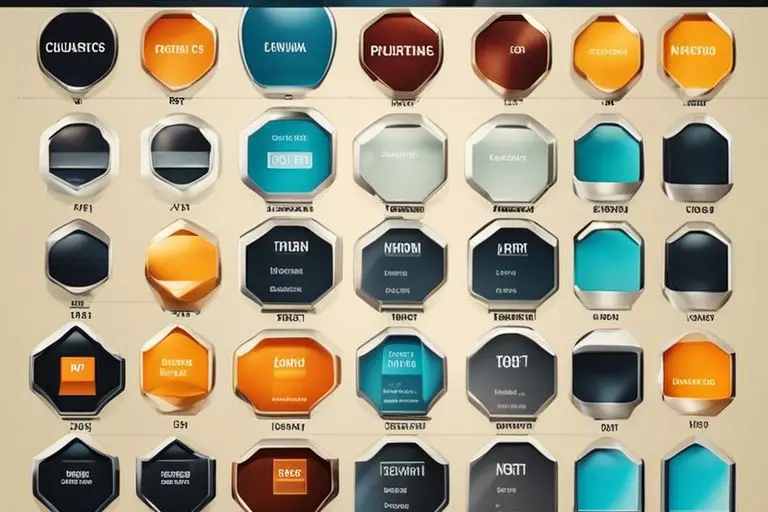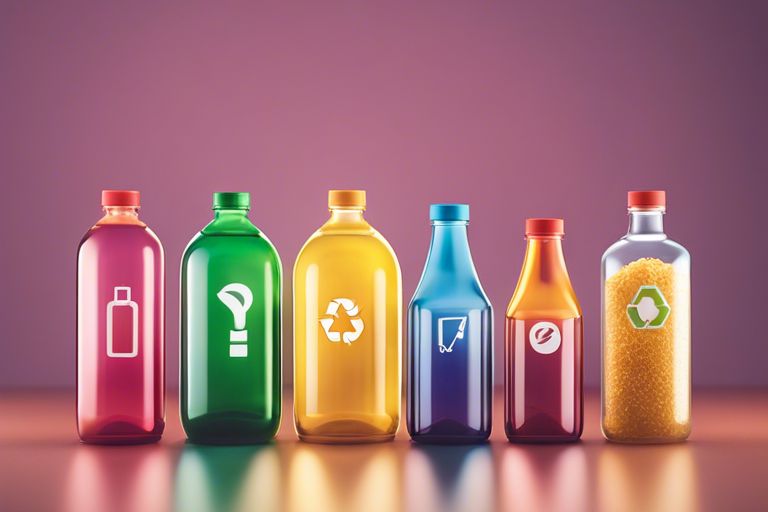Most people interact with various types of plastic on a daily basis without even realizing it. Plastics are versatile materials that are used in a wide range of applications due to their durability and flexibility. Understanding the different types of plastic and their specific uses can help us make informed decisions about their impact on the environment and our health. In this blog post, we will explore the various types of plastic commonly used in our daily lives and their benefits and risks.

Key Takeaways:
- Polyethylene (PE): Commonly used for packaging, plastic bags, and bottles due to its versatility and low cost.
- Polyethylene Terephthalate (PET): Used for making food containers, beverage bottles, and clothing fibers due to its durability and ability to be recycled.
- Polyvinyl Chloride (PVC): Known for its versatility and resistance to chemicals, used in construction, healthcare products, and packaging.
The Seven Major Types of Plastic
One of the most common ways to categorize plastic materials is by their resin identification code, which ranges from #1 to #7. Each type of plastic has unique characteristics that make it suitable for specific applications. Here are the seven major types of plastic:
| PET | Polyethylene Terephthalate |
| HDPE | High-density Polyethylene |
| PVC | Polyvinyl Chloride |
| LDPE | Low-density Polyethylene |
| PP | Polypropylene |
Polyethylene Terephthalate (PET)
Majorly used in the manufacturing of plastic bottles for beverages and food items, PET is popular due to its lightweight, transparent, and shatter-resistant properties. It is easily recyclable and commonly found in everyday products such as water bottles and food containers.
High-density Polyethylene (HDPE)
With its high strength-to-density ratio, HDPE is widely used for making plastic crates, pipes, and durable containers. The material is known for its resistance to chemicals and moisture, making it suitable for applications where durability and strength are required.
Types of HDPE include milk jugs, detergent bottles, and grocery bags. This plastic is not only recyclable but also considered safe for food storage. However, improper disposal of HDPE can lead to environmental pollution, as it can take hundreds of years to decompose naturally. Recycling HDPE products is crucial to reduce plastic waste and environmental impact.
After considering the characteristics of each type of plastic, it is important to choose the right one for a specific application to maximize its benefits while minimizing environmental harm.
Applications of Plastic in Various Industries
Packaging Industry Uses
Assuming a crucial role in the packaging industry, plastic is used for a wide range of applications such as food packaging, beverage containers, and product packaging. Various types of plastic, including PET, HDPE, and PVC, offer lightweight, durable, and cost-effective solutions for protecting products during transportation and storage.
Construction and Building Material Uses
Packaging materials are just a fraction of where plastics are utilized. With its versatility and adaptability, plastic plays a significant role in the construction and building material industry. From PVC pipes for plumbing to insulation materials, plastic offers a range of benefits including durability, corrosion resistance, and cost-effectiveness.
Specialty Plastics and Engineering Polymers
Not all plastics are created equal. Some are tailored for specific applications, resulting in the category known as specialty plastics and engineering polymers. These high-performance materials exhibit exceptional properties that make them ideal for various demanding industries and unique applications. To learn more about different types of plastics and their uses, check out What Are the Different Types of Plastics and Their Uses?.
Polycarbonate (PC)
Specialty polymers like Polycarbonate (PC) are renowned for their remarkable impact resistance and clarity. They are commonly used in products that require strength, transparency, and heat resistance. PC is often found in applications such as safety goggles, protective gear, electronic housings, and automotive components.
Polyamide (Nylon)
The versatility and strength of Polyamide (Nylon) make it a preferred choice for engineering applications that demand durability and toughness. This polymer exhibits excellent wear resistance and can be reinforced with fillers to enhance its mechanical properties. Polyamide is widely used in manufacturing components like gears, bearings, bushings, and structural parts in various industries.
Polymers like Polycarbonate (PC) and Polyamide (Nylon) offer a unique set of properties that cater to specific industrial needs. While PC provides exceptional impact resistance and clarity, Polyamide demonstrates outstanding strength and versatility. These specialty plastics play a crucial role in advancing technology and innovation across multiple sectors.

Environmental Impact and Recycling
Once again, if you want to learn more about the different types of plastic and how they are used, check out this Types of Plastic | Learn What is Plastic Made Of & Different ... resource.
Effects of Plastic on the Environment
Any plastic waste that is not properly disposed of can have detrimental effects on the environment. Plastic pollution is a significant problem that impacts marine life, terrestrial ecosystems, and human health. Animals can mistake plastic items for food, leading to ingestion and often death. Additionally, plastic pollution can contaminate soil and water sources, posing a serious threat to wildlife and habitats.
Recycling and Sustainable Practices
To address the environmental impact of plastic, recycling and sustainable practices are crucial. Recycling plastic helps reduce the amount of waste that ends up in landfills or polluting the environment. Plastic can be recycled into a variety of products, conserving natural resources and energy. Implementing sustainable practices such as reducing single-use plastics and promoting the use of biodegradable alternatives can also make a significant difference.
Plastic recycling is vital for reducing environmental harm and promoting a more sustainable future.
To wrap up
Considering all points discussed in the different types of plastics and their uses, it is evident that plastics play a vital role in various industries due to their durability, flexibility, and versatility. From everyday items like packaging materials and containers to specialized applications like medical devices and electronics, there is a wide range of plastics available to suit different needs. Understanding the characteristics and uses of each type of plastic is crucial for making informed decisions about their applications in order to maximize their benefits while minimizing environmental impact. By making conscious choices and recycling plastics whenever possible, we can contribute to a more sustainable future for our planet.
FAQ
Q: What are the different types of plastic and their uses?
A: There are several types of plastics used in various industries and applications. Some common types include:
- Polyethylene (PE): Used for packaging, bottles, and containers.
- Polypropylene (PP): Commonly used in food containers, automotive parts, and textiles.
- Polyvinyl Chloride (PVC): Used in construction, healthcare products, and packaging.
- Polyethylene Terephthalate (PET): Widely used for beverage bottles and clothing fibers.
- Polystyrene (PS): Found in disposable cutlery, packaging, and insulation.
Q: What are the properties of different types of plastics?
A: Each type of plastic has unique properties that make it suitable for specific applications. Some properties of common plastics include:
- Polyethylene: Flexible, chemical-resistant, and impact-resistant.
- Polypropylene: Lightweight, heat-resistant, and resistant to fatigue.
- Polyvinyl Chloride: Durable, weather-resistant, and flame-retardant.
- Polyethylene Terephthalate: Clear, strong, and easily recyclable.
- Polystyrene: Rigid, lightweight, and good insulating properties.
Q: How are different types of plastics recycled?
A: Plastics can be recycled through various processes, depending on their type. Common recycling methods include:
- Mechanical Recycling: Involves melting and reshaping plastics into new products.
- Chemical Recycling: Breaks down plastics into their chemical components for reuse.
- Biodegradable Plastics: Made from renewable sources and can decompose naturally.
- Pyrolysis: Converts plastics into fuel or chemical feedstocks through high-temperature processing.
